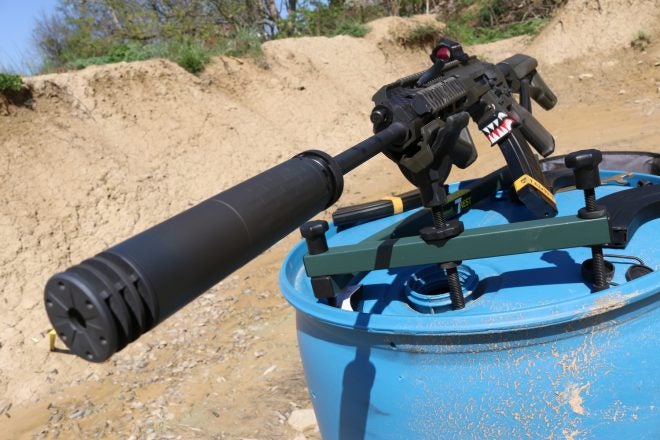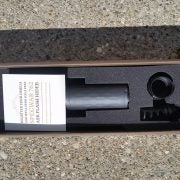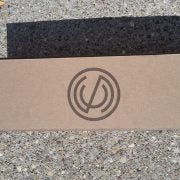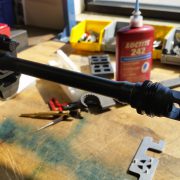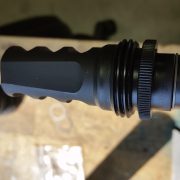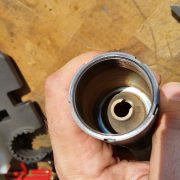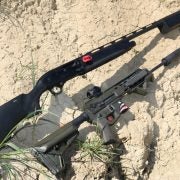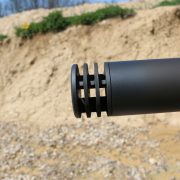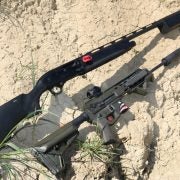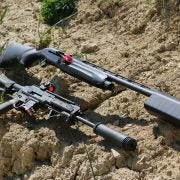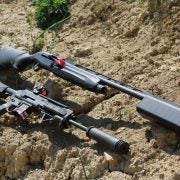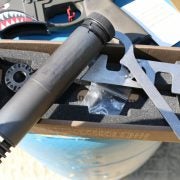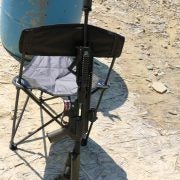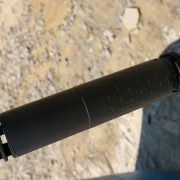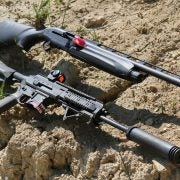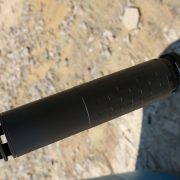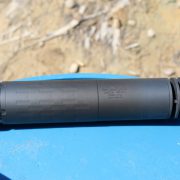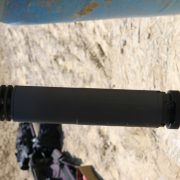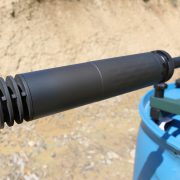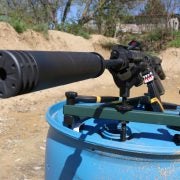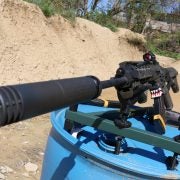Since picking up my FFL and SOT, I have fallen in love with suppressors and shoot with them as often as I can. Unfortunately, most competition shooting (outside PRS) does not allow the use of suppressors, often labeling them as “unfair” accessories due to their recoil reduction. However, its the same reason (coupled with shooting without hearing protection) that makes them such a critical accessory, to the point that I do not build a weapon system without the provision for a can.
While technology in suppressors has been progressing rapidly, the legacy of suppressors is that they are typically heavy and bulky. Using stainless steel tubes and heavy baffles tends to make them impractical for long-barrel rifles and un-holsterable for handguns. Most 300 caliber cans have been 1.5 pounds or greater which on a 16-20″ barrel acts as a big fat weight on the end of a long cantilever.
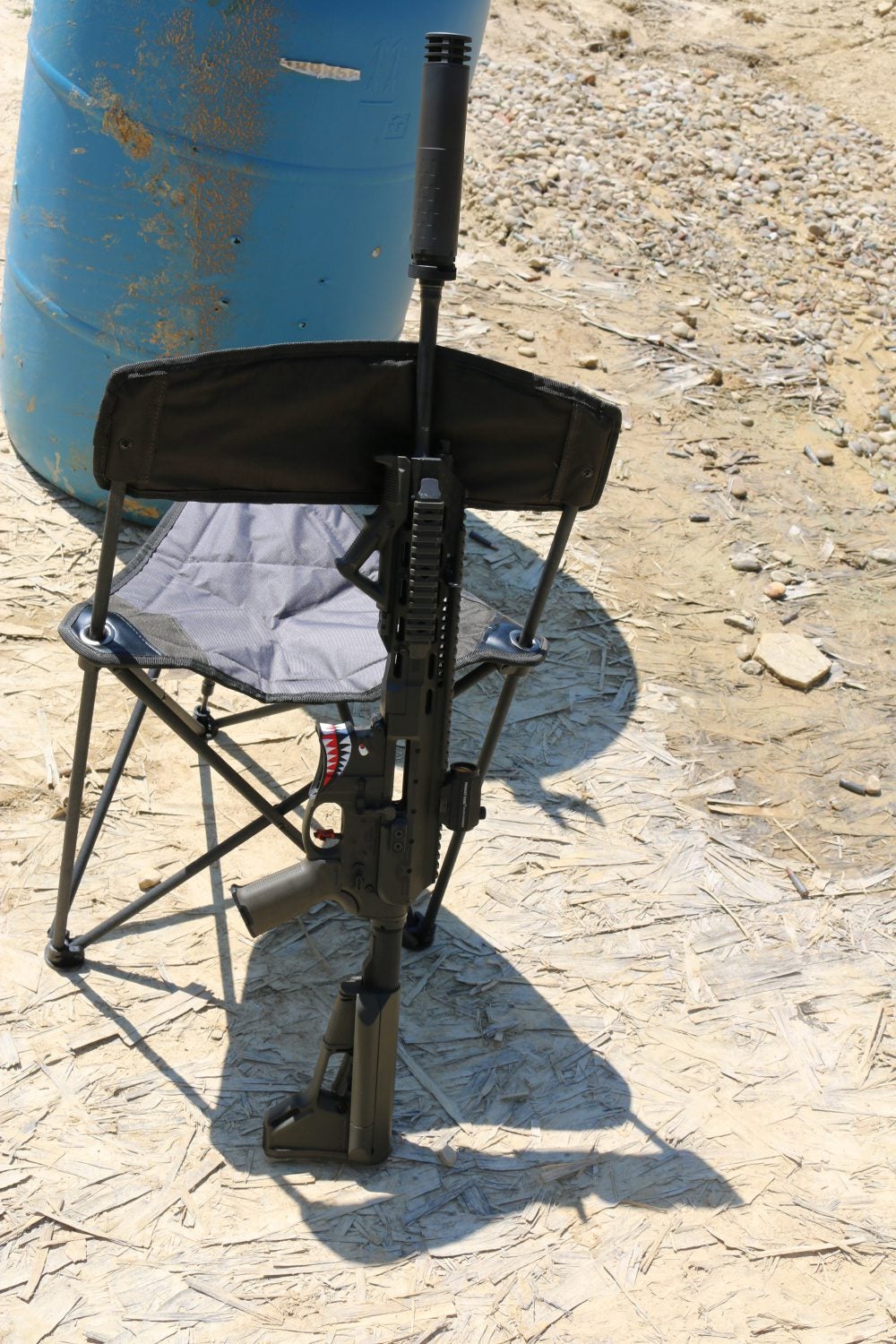
SilencerCo set out to break that .300 caliber mold. Using “a combination of all the best features from our .30 caliber center-fire rifle silencer lines…” SilencerCo created a full-auto and magnum-rated .30 can that clocks in at a scant 14 ounces*. The other specs are equally diminutive (relatively speaking). Diameter is 1.56″ and the length is 7.09″ yet the can remains rated for .300 Win Mag.
*Note- Direct thread configuration. Adding various accessories will increase the weight.
Full Ratings per SilencerCo:
- .223 / 5.56 – 10″
- 300 BLK – 8″
- .308 Winchester – 16″
- .300 Winchester Magnum – 20″
This basically breaks down to the can can handle about ~12,000 PSI or less, so the shooter can adjust based on their other calibers.
The Omega Suppressor & Mounting
LIke other SilencerCo products, the Omega can comes in a cardboard box with pre-cut foat including all the accessories. The box is printed on the outside smartly with minimalist details but enough to communicate the technology in side. As always, SilencerCo’s marketing and product teams are top-notch.
Opening the box to the first layer yields the suppressor in its direct-thread configuration and the ASR brake and ASR (Active Spring Retention) Suppressor mount. Stowed on the side are the two included tools (the Saker Basic Tool and Harvester Big Bore MultiTool and on the bottom is a set of peel washers and the manual (available online here). For those wanting to register their suppressor, SilencerCo will send a free ASR flash hider.
The can itself is deceptive. Used to heavy-duty cans like those from Elite Iron and similar companies, one expects heft from the suppressor. On the contrary, the Omega feels like a featherweight. Manipulating it, I was pleasantly surprised to see the can was back-heavy, meaning the baffle stack tended towards the rear. All too often companies put their baffles towards the front giving the first baffle a large blast chamber which while increasing suppressor life by reducing baffle wear, biases weight even further to the front of gun.
The can comes pre-equipped with SilencerCo’s Anchor Brake, which looks like a stack of flying saucers. The Anchor Brake is directly threaded to the end cap and removable for replacement with other caliber end caps (for example, a smaller exit hole for .223) or to reduce weight even further without the brake. By itself, its light and was always included during testing as I did not have any of the other adapters.
Mounting the Omega can be accomplished two ways, both requiring 5/8×24 threads concentric to the bore. The Omega can be manually wound directly onto the end of a barrel via the direct thread adapter, which it lines up easily and showcased one of SilencerCo’s small details that make a big deal: the direct thread adapter is relieved the first thread for barrels that do not have a corresponding relief cut behind their threads. Basically, if your barrel has threads, this can will go on it.
The other option is SilencerCo’s ASR adapter, which is a quick-detach system comprising of a ASR compatible muzzle device and the ASR adapter for the suppressor. To use it, one must mount the device to the barrel and swap out the direct-thread adapter to the ASR adapter. SilencerCo includes peel washers for timing the muzzle brake and specifically advises against using crush-washers, which the uneven crushing can cause deviation of the device and subsequent baffle strikes.

For testing, I used a personally owned Faxon ARAK-21 using three calibers, 5.56, 300 BLK, and 7.62×39 and an AR-15 in 5.56 as a direct impingement reference point. The ARAK was chosen as it was able to adjust gas to compensate for increased back-pressure, had multiple calibers, and could turn the gas off and become a bolt-action weapon. The 7.62×39 was used with the ASR mount, the 300 BLK the direct thread, and the 5.56 barrels used were direct thread via an adapter purchased from Precision Armament.
Mounting the ASR was simple. With the upper receiver in the appropriate vice and threads cleaned, the mount was installed and torqued to the recommended 20-30 ft-lbs. It too a few permutations of peel washers to get the device to the recommended settings, but in about 10 minutes the ASR brake was installed and ready for action. The Harvester Multi-tool would have worked, but I had a torque wrench so I did not use it.

Swapping the can from direct-thread to ASR was equally simple, although I needed a vice to hold the can still to get the direct thread mount off. The Harvester multi-tool came in handy this time around. Both the Anchor Brake and Direct Thread Adapter use a pattern of drilled holes to interface with tools. The HMT has the pattern to interface with these and once the can was viced in place, removed the adapter without issue.
Note- For all future swaps, my hands were sufficent to remove and tighten the adapters.
To mount the ASR, thread the ASR adapter into the can (uses the Saker tool to tighten), thread the complete assembly onto the ASR muzzle device, and tighten the lock ring. The ASR adapter and muzzle device then mate together using the threads on the outside of the muzzle device and small serrations on the back to lock the can into place. Its critical to truly hand tighten the complete ASR can to the muzzle device prior to locking it in place. If the can can move, release the lock ring, re-tighten, and lock in place.
Shooting With the Omega
Prior to shooting the can, function tests were conduced on all weapons. During those tests, it was noted that the ASR brake on the 7.62×39 was a solid muzzle device stand-alone, using a typical three blast chamber arrangement. The ASR brake did not have any vectoring for reducing muzzle climb, which I prefer as a good shooting stance will remove muzzle rise and too much vectoring pushes a muzzle down for me.
Note- Testing was conduced with the following ammunition:
- 7.62×39: Red Army Standard 124gr and Wolf 123 grain
- 300 BLK: Gemtech Subsonic, Gorilla 220 Grain Subsonic, Ozark Ordnance Super Sonic, Random hand-loads.
- 5.56: Federal XM193, Freedom Munitions 55 Grain Re-manufactured Brass-Cased.
Loading up a full magazine of 30 rounds of Red-Army, I mounted the can via the ASR system and simply started pulling the trigger. Used to the muffle of my double-hearing protection (Peltor Electronics & SureFire EP7’s), I enjoyed hearing the Peltor not muffling the gunshots. There was no discernible break in sound amplification. Confident that the can was working correctly, I removed my ear pro and proceeded to dump the magazine with nearly wanton abandon (the local range puts out old cars as targets, I was intent on swiss-cheesing it).

I noticed three things immediately:
- The sound was pleasant with only the supersonic crack ruining an otherwise enjoyable audible experience
- Weight on the front of the rifle was not too noticeable, except when swinging it from target to target
- Back-pressure increased significantly.
The third component was not significant, as I had not yet reduced the gas setting on the rifle. Dropping it down to the ARAK’s lowest setting for the caliber, which is optimized for suppressed, the gun dropped back into its normal rhythm.
Its common for baffle-construction suppressors to increase back-pressure, sometimes significantly. There are two ways to look at this, it runs a gun harder (assuming it does not have adjustable gas systems), or that it is capture enough energy to suppress the weapon. And yes, there are some new methodologies to capture energy (like OSS), but those come at cost, weight, and size penalties. I take the latter perspective and know the can is doing its job.
Content that the can is doing its suppressive job, I was keen to test its “full-auto” rating. Using my paintball-trained trigger finger and a HiperFire 24C trigger, I put four magazines into the can as fast as I could reload. Suffice to say, it got hot (melted nylon when I set it down, oops!), but held without issue. Impressive.
Letting it cool for a second, I set up the range for target shooting. Shooting at only 50 yards (range has max 50 yard bays, while others are under construction), I proceeded to put down groups on paper. The Red Army was shooting roughly 2″ at 50 yards using hasty support (shooting on a blue barrel) and the Primary Arms Advanced Micro Dot. Suffice to say, I was pleased. With the can cooled, I tested POI shift, which was about 2″ at 50 yards, but came at significant increase in accuracy. Groups dropped to about 1.5″ (same shooting position in very hasty form).
Happy with the Russian ammunition performance, I swapped over to the 300 BLK kit and changed the can to its direct thread mount, which I must add was easy to do in the field assuming the can has been allowed to cool.

Repeating testing with 300 BLK was a snap and more enjoyable. 300 BLK is just softer shooting and when combined with the can made for a truly “22LR-like” experience. The Omega ate all the super-sonic I could feed it (147 grain HP re-loads) and practically begged me to move to subsonic. Using subs, the can was whisper-quiet (SilencerCo rates it at 119 dB) and I say that as the 119 dB is only for the split-second. The action moving is louder to the ear than the explosion hitting the open air.
Taking advantage of the ARAK’s gas shut-off feature, I shot the weapon in bolt-action mode. Shooting subs in a bolt-action is serene. With no hearing protection and only the affirmative thud of the 220 grain round further ventilating the car, I wish I could have stayed at the range all day. Alas, the subsonic ammo does not grown on trees.
Repeating accuracy testing with 300 BLK saw far less POI shift, only about .5″ at 100 yards vertically increasing which tells me that the can had no POI shift, only the result of slightly increased velocity from the supersonic ammunition. Sub-sonics had no discernible POI using the direct-thread adapter.
Additional testing was conducted on 5.56 platforms with similar results. Similar to the 7.62×39, back-pressure increased significantly. On an 18″ rifle gas barrel using an SLR gas block, lock-back was reduced by 5 clicks (out of 17 slots total, with the weapon working at setting 10). It was also noted that 5.56 had a bit more crack at the muzzle than either .30 cal round. Suffice to say, the Omega can handle anything 5.56 can throw at it.

The Good:
- A true light-weight versatile can with excellent suppression.
- Modular with direct-thread, ASR, and various muzzle mounts to suit nearly any usage.
- Handles “full-auto” with ease (just don’t touch it to anything flesh or plastic!)
- ASR mount is intuitive and easy.
- Includes pouch and tools and two muzzle devices (if one submits for registration),
The Notable:
- Its not the truly lightest .30 cal can, but it is the lightest “full-auto” rated.
- Does require tools to disassemble.
- Available in black and FDE
The Bad:
- Retails for $1,130, but street prices have them around $880 (which if $880, puts it back into the “Good” category to me).
Final Thoughts:
With the myriad of options popping up in the market, it has never been a better time to be a suppressed shooter. Despite ATF delays, can continue to expand rapidly and much of that is due to SilencerCo. SilencerCo has been instrumental to getting word out that suppressors are, in fact, legal and (relatively) easy to acquire as part of their “Fight the Noise” campaign.
The Omega fights the “noise” indeed. As a modular option, it opens up a wide array of options for the shooter so long as the bullet is .30 cal or smaller. 5.56 shooters, 5.7, 6.5, and others can all shoot the Omega with solid results.
Combined with its “full-auto” rating and agreeable weight, this is an easy product to recommend. At full retail price, it would be difficult to fully recommend without also recommending other options, but at the street pricing for the Omega the value shines through.

Check out additional details and information at www.silencerco.com
 Your Privacy Choices
Your Privacy Choices
